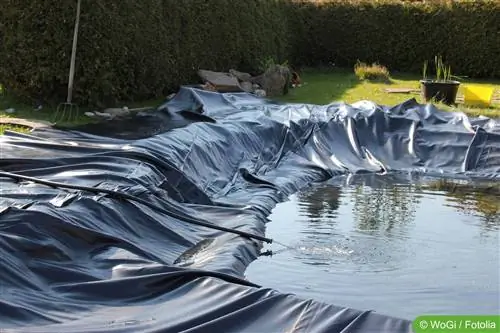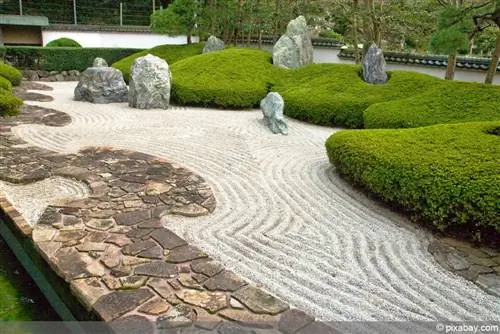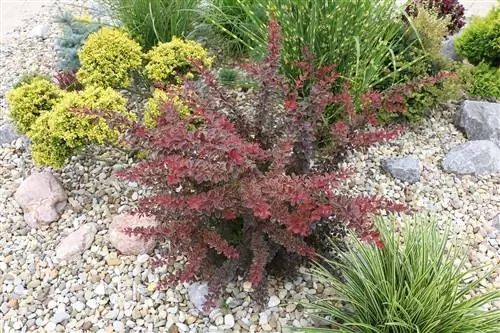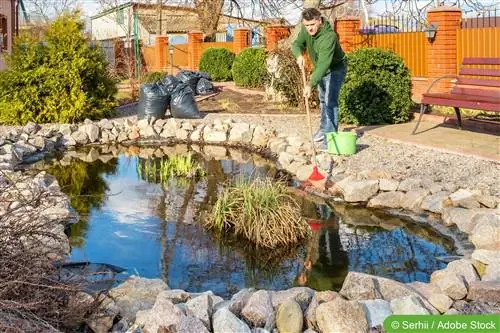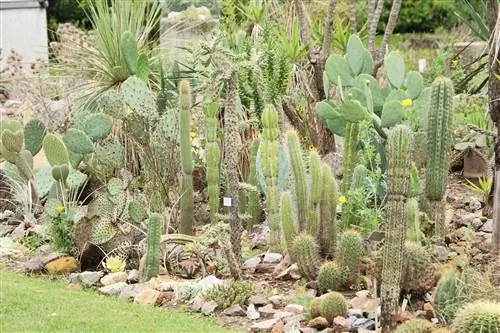- Author admin [email protected].
- Public 2023-12-17 03:39.
- Last modified 2025-01-24 12:45.
There are many reasons for building a garden pond. Water has a magical appeal. Read here what you need to consider when creating a pond. You should roughly calculate these costs.
In the great outdoors we find lakes and rivers to be an extraordinary enrichment of the landscape - the appearance changes, the straight surface of water has a calming effect. But water also offers opportunities for the development of a very rich, different kind of flora and fauna, which dealing with offers special adventure opportunities.
The right location
Even though a water barrel on the terrace can be installed very quickly, the plan for a garden pond rarely comes to fruition overnight. You should decide on the location and size of the future pond not in winter, but in summer. Then trees and bushes are leafy and the proportions as well as the distribution of light and shadow can be assessed more realistically.
Various aspects must be taken into account when planning a garden pond. A body of water encourages you to look at it. Their place is therefore primarily in places that are frequently used: in the immediate vicinity of the house, at a seat or at the entrance to the house. If this space offers optimal development opportunities for the surrounding plants in terms of the soil, the incidence of light or an ideal microclimate, the desired overall impression of lush plant growth that matches the water will soon be created. Plants that emerge from the water generally have soft tissue and bend over easily. Wind protection must therefore be taken into account.
Size and shape of the pond
The water area should not be too small. Even if you have planned 2-3 water lilies and a corresponding planting of swamp iris, pine fronds or cattails, a size of at least 4 x 2.5 m is required. Many garden ponds are smaller - much to the later chagrin of the owners.
The number is too big, prefabricated ponds look much larger before they are installed than they do later when they are planted. Which shape is chosen often depends on the style of the garden. A natural-looking, rounded shape is more suitable for a park-like area. In small gardens or near houses, geometric, especially rectangular shapes will be much more appropriate. Even if the natural-looking shape that blends with the surroundings is popular today, in the long term you will enjoy the contrast between straight edges and the diverse shapes of the plants. The range of finished pools takes many wishes into account.
The right depth
More depth means more excavation and therefore higher costs. So you will try to stay as flat as possible. A pond with pure plant growth needs a maximum water depth of 40-60 cm. It does not have to be deeper, but can be much shallower in some zones. However, if one assumes that fish are to be used and kept alive over the winter, 60 cm is not enough, as there is a risk that a layer of ice will form at its full depth in harsh winters. At least in one place the water depth must be 80 cm or, better, 100 cm. And the fish will retreat into this if necessary. Such a depth is also beneficial if the pond is in full sun.
The pond bottom
The surface must definitely be firm and must not give way. This can be achieved by shaking off an approx. 10 cm thick layer of sand on the bottom of the pond or by adding an appropriate layer of lean concrete. For pools with different depths, it is necessary to fit them as precisely as possible, which is not always easy. Marking the shape of the pool and setting it up several times are necessary until everything is right. As a preventive measure, the excavation is made a little larger and, after fine-tuning with a spirit level, sand is added to fill the remaining cavities. A layer of sand is also necessary on stony ground. It goes without saying that roots, stones, etc. are carefully collected to prevent injuries to the pond skin. Otherwise, retailers offer pond fleeces, which are non-rotting mats that are laid under the films and protect them against injuries.
Filling and emptying pond water
Frequent water replacement is hardly an option. The water normally stays in the pool even in winter. Unless it is a fountain system or ponds for summer use only. Complete draining would destroy the winter forms of many aquatic plants. However, a general cleaning is recommended once a year in early spring. A pump or suction is sufficient for this if there is a slope. Inexpensive pumps can also be connected to any hand drill. The range is large up to the powerful mud pump. A drain device is not always necessary, but for complete emptying you need a sludge shaft, a depression that can completely accommodate the pump's suction basket. An extra depth of 20-25 cm should be sufficient for this. Where there is no power connection, a built-in drain is required, ideally combined with a standpipe as an overflow.
Safety measures
The authorities only expect notification and partial approval requirements for larger construction projects, especially if they involve concrete garden ponds. However, it is better to insure yourself by making an inquiry to the responsible building authorities or, if natural water is tapped, to the water authority of the municipality or district.
Plants for different water depths
There are a few types of water lilies that have the highest demands on water depth: Nyniphea lutea, the yellow pond lily, also called Mummel, and Nymphea alba, our native white water lily, as well as some varieties derived from them. Both grow wild in German waters and can tolerate depths of up to 1.50 m. However, most water lilies, and especially other aquatic plants, have to be shallower. Most varieties do just fine with a depth of 40-8d cm. Nympheapygmea alba even needs 10-20 cm of water. Especially when plants are still young, a shallower water level is always better than a water level that is too high because it warms up better. However, if flowering is to occur, the desired water level is required. Protruding leaves with stems clearly visible remind the pond owner that the plants need more water.
Wildlife of the garden pond
If you have a body of water to offer as the basis for a wetland biotope, you don't have to do much and will still enjoy the many animals that gradually appear. As we all know, all life comes from water. Without any action on our part, a food chain and thus a community of life is formed, which begins with the water flea. This tiny crustacean with the pretty name Daphnia moves forward jerkily, is only about 1 mm thick and can soon be found in every puddle of water. where it feeds on algae. Its fate is to serve as food for other guests in and around the garden pond, especially the fish. In addition to water fleas, there are a variety of tiny creatures, such as: E.g. hoppers, parameciums, water mites, mussel crustaceans, mayfly larvae, etc., which on the one hand act as he alth police and consume plant and animal remains, but on the other hand are also eaten by higher animals.
Costs for pond construction
If you want to create a pond in your garden, you shouldn't ignore the costs of such a purchase. Basically, you should plan for costs for the excavation of the earth, the pond liner, the pump including filter as well as the plants. However, these costs cannot be quantified precisely because they vary entirely depending on the individual wishes of the garden owner. To save costs, you can of course carry out the pond excavation yourself. The appropriate equipment can be rented inexpensively. High-quality foil should be used for pond construction; the costs can vary depending on the quality and size. The average value for a square meter is around 1000 euros. You can get the pump you need for your garden pond at any hardware store, but expect a price of around 300 euros. The prices for the pond plants, on the other hand, can vary greatly, perhaps even your garden neighbor has a few useful offshoots to give away

